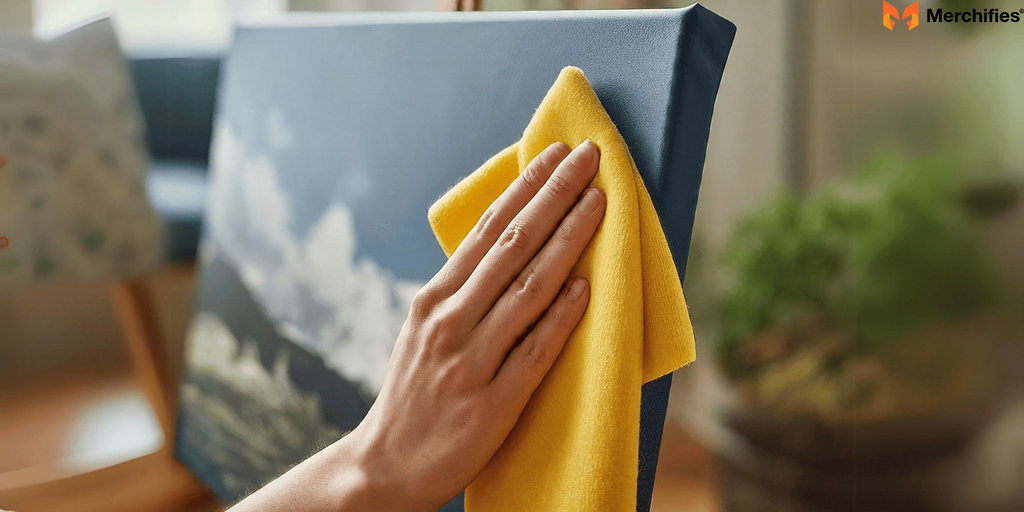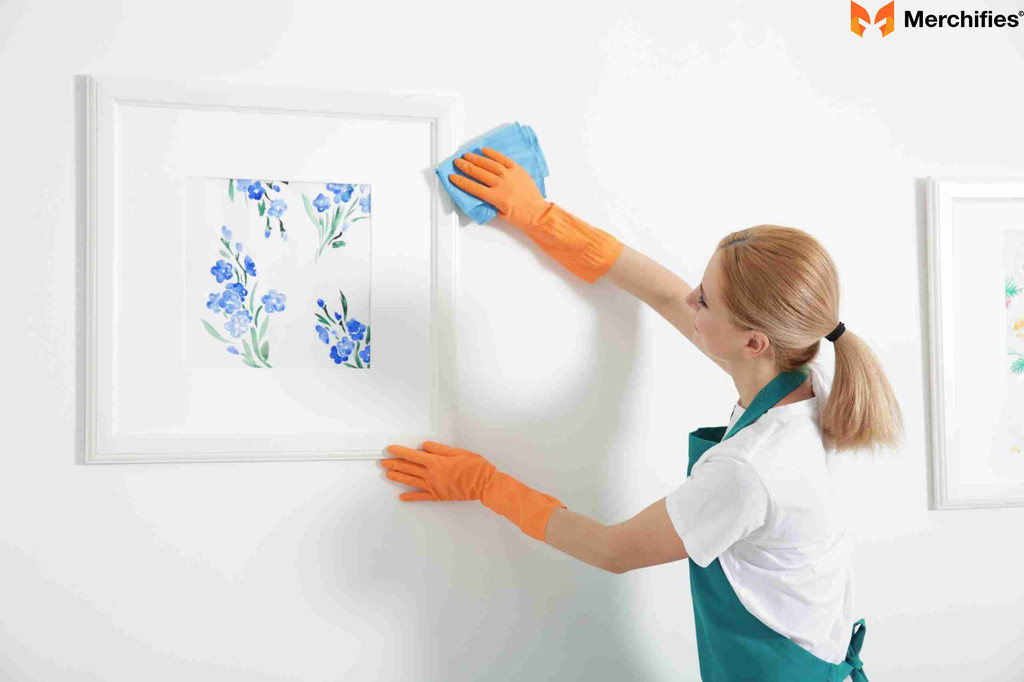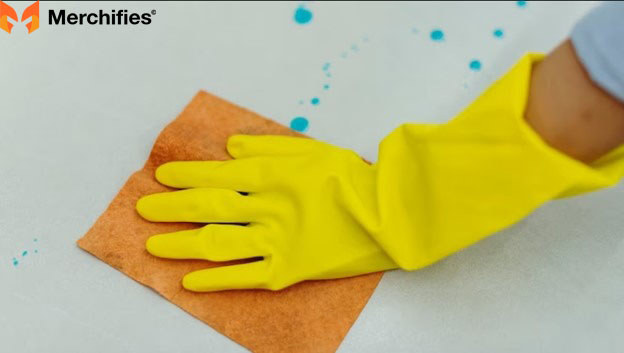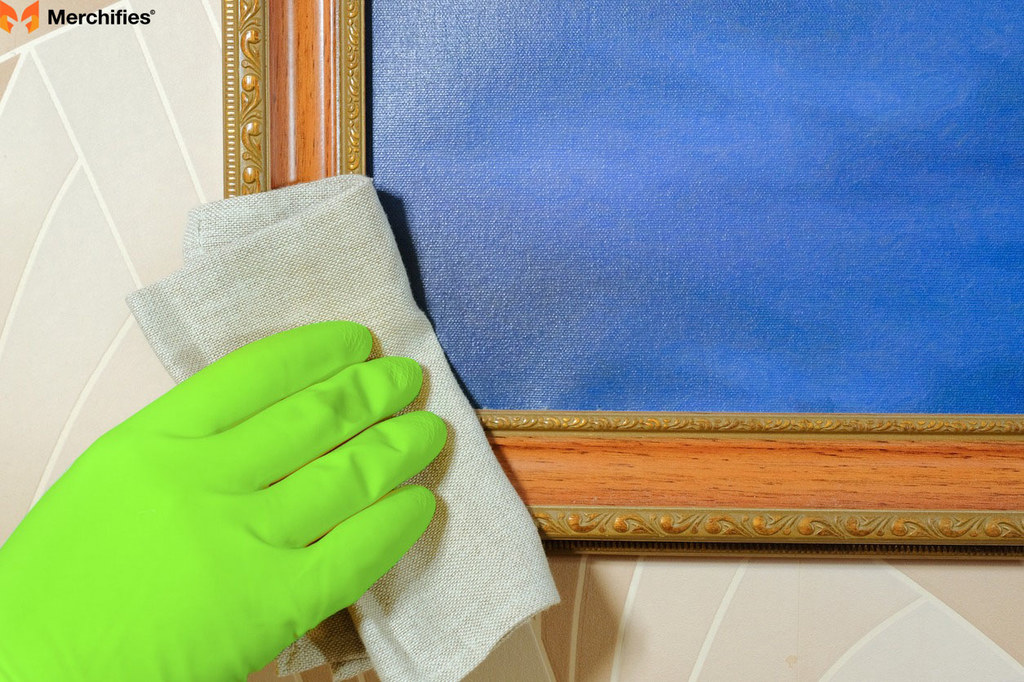20+ How To Clean A Canvas Print: Keep Your Artwork Looking Pristine

Blog Post Contents
After spending over two decades helping American families preserve their treasured artwork, I've learned that knowing how to clean a canvas print properly can extend its life by years. Moreover, proper canvas print cleaning techniques prevent costly damage while maintaining vibrant colors and sharp details.
Understanding Canvas Print Construction and Care Requirements
Think about what a canvas print actually is. It's ink, your chosen image, printed directly onto a woven fabric that's stretched over a frame. That fabric, while sturdy-looking, is actually pretty porous. And that printed surface? It can be sensitive to harsh stuff. How To Clean A Canvas Print? Messing with the wrong cleaning methods can lead to colors fading or even damage to the print itself. Trust me, I've seen it happen, and it's not pretty.
Canvas print cleaning requires understanding the delicate nature of the materials involved. Canvas prints consist of specialized inks applied to textured fabric surfaces, making them more vulnerable than traditional photographs. Furthermore, improper canvas print maintenance can result in irreversible color loss, texture damage, or complete print deterioration.

The Science Behind Canvas Print Vulnerability
Canvas cleaning challenges stem from the porous nature of fabric substrates. Unlike glass or plastic surfaces, canvas material absorbs moisture and cleaning solutions, potentially causing inks to run or fade. Additionally, the texture of canvas prints can trap dirt particles, making aggressive cleaning counterproductive.
In my professional experience, most canvas print damage occurs when homeowners apply glass-cleaning techniques to fabric artwork. Canvas prints require specialized cleaning methods that respect both the ink chemistry and fabric structure.
Essential Canvas Print Cleaning Supplies and Tools
You won't need a whole arsenal of cleaning supplies for this. Keep it simple.
Canvas print cleaning success depends on using appropriate tools and materials. Professional canvas maintenance requires gentle, non-abrasive supplies that won't damage delicate ink surfaces or fabric textures. Moreover, selecting the right cleaning supplies prevents common mistakes that lead to permanent artwork damage.
Basic Cleaning Equipment for Canvas Care
For Light Dusting: Grab a super soft, lint-free microfiber cloth. Those are the best for not scratching. A gentle feather duster can also work wonders. Some folks even use the soft brush attachment on their vacuum cleaner, but keep the suction on the lowest setting.
Microfiber cloths represent the safest option for routine canvas print cleaning. These specialized cleaning cloths trap dust particles without scratching delicate surfaces. Additionally, lint-free materials prevent fiber residue from adhering to your canvas artwork.
Feather dusters provide excellent alternatives for regular canvas maintenance, particularly for textured surfaces where cloths might catch. However, ensure your feather duster is clean and dry before each use to prevent transferring oils or debris.
Gentle Cleaning Solutions for Canvas Prints
For Mild Grime and Marks: Distilled water is your friend here. It's pure and less likely to leave any residue. You might also want a clean spray bottle for a very light mist, if needed.
Distilled water serves as the foundation for safe canvas print cleaning. Unlike tap water, distilled water contains no minerals or chemicals that could leave deposits on your canvas surface. Furthermore, pure water reduces the risk of chemical reactions with canvas inks or protective coatings.
For Minor Stains (Use with Extreme Caution): This is where you tread lightly. A tiny bit of mild, pH-neutral dish soap (the kind without all the harsh chemicals) mixed with distilled water can sometimes do the trick. You might also consider isopropyl alcohol or diluted white vinegar for specific stains, but we'll get to that – proceed with caution! And have some cotton balls or swabs handy for targeted application.
pH-neutral cleaners maintain the chemical balance necessary for safe canvas print cleaning. Alkaline or acidic solutions can damage canvas inks, cause color shifts, or break down protective coatings. Therefore, always verify the pH neutrality of any cleaning solution before use.
Step-by-Step Canvas Print Cleaning Methods
Canvas print cleaning requires systematic approaches that progress from gentle to more intensive methods. Professional canvas care always begins with the least invasive techniques before considering stronger cleaning solutions. Additionally, proper cleaning methodology ensures you don't inadvertently damage your valuable artwork.
Routine Dusting: Essential Canvas Print Maintenance
Dust is the silent enemy of all artwork. Make it a habit to dust your canvas prints regularly – maybe once a month. Just take your soft microfiber cloth or feather duster and gently sweep across the surface. If you're using a vacuum, make sure that soft brush attachment is on, and the suction is low. You don't want to pull at the canvas.
Regular dusting represents the most important aspect of canvas print maintenance. Dust accumulation creates abrasive surfaces that can scratch canvas textures during cleaning attempts. Moreover, consistent dusting prevents the need for more intensive cleaning procedures that carry higher risks.

Professional Dusting Techniques
Canvas dusting requires gentle, systematic motions that follow the canvas grain direction. Cross-grain movements can damage canvas textures or cause inks to smear. Additionally, proper dusting frequency prevents dust from becoming embedded in canvas pores where it's harder to remove.
From my experience helping families maintain their canvas collections, weekly light dusting prevents monthly deep cleaning needs. Preventive canvas care saves both time and reduces the risk of cleaning-related damage.
Cleaning Light Grime and Surface Dirt
Sometimes, just dusting isn't enough. If you've got some light grime or a little splatter, dampen your microfiber cloth very slightly with distilled water. I mean barely damp – you don't want to soak the canvas. Gently wipe the affected area in a single direction. Then, take a clean, dry part of the cloth and immediately dry the area. Letting water sit on the canvas is a no-no.
Light grime removal requires careful moisture control to prevent water damage to canvas materials. Excess moisture can cause canvas stretching, ink running, or mold development. Furthermore, immediate drying prevents water spots from forming on treated areas.

Moisture Control in Canvas Cleaning
Canvas print cleaning with water requires understanding fabric moisture absorption rates. Canvas materials absorb liquids quickly, making controlled application essential for safe cleaning. Additionally, proper drying techniques prevent moisture-related damage like warping or mold growth.
Professional canvas restoration services use humidity-controlled environments because moisture management is critical for fabric artwork preservation. Home canvas cleaning requires similar attention to moisture control for successful results.
Addressing Noticeable Marks and Stains
How To Clean A Canvas Print? For those slightly more stubborn marks, you can try a very diluted solution of that mild dish soap and distilled water. Before you even think about touching your print, do a patch test in a corner that's not easily seen. If it looks okay, gently apply the solution with a soft cloth or cotton swab, using a blotting motion rather than rubbing. Then, take a clean cloth barely dampened with distilled water to wipe away any soap residue. And again, dry the area thoroughly.

Stain removal from canvas prints requires extreme caution and systematic testing. Patch testing reveals how your specific canvas material and inks react to cleaning solutions before risking visible areas. Moreover, blotting techniques prevent spreading stains or forcing them deeper into canvas fibers.
Safe Stain Treatment Protocols
Canvas stain removal success depends on understanding stain chemistry and canvas material interactions. Water-based stains respond differently than oil-based marks, requiring tailored cleaning approaches. Additionally, immediate treatment prevents stains from setting permanently into canvas pores.
Throughout my career in art preservation, I've seen countless examples where improper stain treatment caused more damage than the original mark. Professional stain assessment determines the safest removal approach for each specific situation.
Managing Stubborn Canvas Print Stains
This is where you really need to be careful. For non-water-based stains like ink or some markers, a tiny bit of isopropyl alcohol on a cotton swab, gently blotted, might work. But again, patch test first! For some light mildew or other specific stains, a heavily diluted white vinegar and distilled water solution could be an option – with a patch test, of course. Honestly, for valuable or irreplaceable prints with stubborn stains, your best bet is to call in a professional art restoration service. You don't want to risk making things worse.
Stubborn stain removal represents the highest-risk category of canvas print cleaning. Specialized solvents like isopropyl alcohol can effectively remove certain stains but may also damage canvas inks or protective coatings. Furthermore, professional intervention becomes necessary when stain value exceeds potential cleaning risks.

When to Choose Professional Canvas Restoration
Professional canvas cleaning services possess specialized equipment and expertise unavailable to home cleaners. Art restoration professionals understand canvas chemistry, ink formulations, and safe solvent applications. Additionally, professional assessment can prevent irreversible damage to valuable or sentimental artwork.
Canvas restoration costs often prove less expensive than replacing damaged artwork, especially for custom or sentimental pieces. Professional cleaning also extends canvas lifespans significantly beyond what home maintenance can achieve.
Comprehensive Canvas Print Care Guidelines
Canvas print maintenance requires understanding both immediate cleaning needs and long-term preservation strategies. Proper canvas care extends artwork lifespans while maintaining visual quality and structural integrity. Moreover, systematic canvas preservation prevents many common problems that necessitate intensive cleaning procedures.
Essential Do's for Canvas Print Cleaning
Dos:
- Use the softest, non-abrasive materials you can find.
- Always start with the gentlest cleaning method.
- If you have to wipe, do it gently and in one direction.
- Use minimal moisture.
- Make sure the cleaned area dries completely.
- Always patch test any cleaning solutions in an inconspicuous area first.
Canvas cleaning best practices emphasize gentle techniques that respect fabric and ink sensitivities. Non-abrasive methods prevent surface damage while effectively removing contaminants. Additionally, systematic approaches ensure you don't escalate cleaning intensity unnecessarily.
Advanced Canvas Care Techniques
Professional canvas cleaning incorporates environmental controls, specialized tools, and extensive material knowledge. Home canvas care can achieve similar results by following professional protocols adapted for residential use. Furthermore, preventive maintenance reduces the need for intensive cleaning procedures.
Critical Don'ts for Canvas Print Care
Don'ts:
- Never use harsh chemicals, strong solvents, or abrasive cleaners.
- Don't spray liquids directly onto the canvas.
- Avoid saturating the canvas with water or cleaning solutions.
- Resist the urge to rub vigorously or in circular motions.
- Don't use excessive heat to dry your canvas print.
- Never assume a cleaning method is safe without testing it first.
Canvas cleaning mistakes can cause irreversible damage within seconds of application. Chemical cleaners designed for other surfaces often prove too harsh for delicate canvas materials. Moreover, aggressive cleaning methods frequently spread stains or force them deeper into canvas fibers.
Common Canvas Cleaning Errors
Improper cleaning techniques account for most canvas print damage I've encountered in my restoration work. Direct spray application oversaturates canvas materials, while circular rubbing motions can damage both ink and fabric. Additionally, heat drying can cause canvas shrinkage, warping, or ink deterioration.
Preventive Canvas Print Protection Strategies
The best way to keep your canvas prints looking good is to prevent them from getting too dirty in the first place. Think about where you hang them. Avoid areas with high humidity, direct sunlight (which can fade the colors), and places where they might get splashed or bumped easily, like kitchens or right next to doorways. Also, try to avoid touching the printed surface with your bare hands – the oils from your skin can transfer and attract dust. If you ever need to take a print down or move it, wrap it in protective materials like acid-free paper or bubble wrap.
Preventive canvas care proves far more effective than reactive cleaning for maintaining artwork quality. Strategic placement protects canvas prints from environmental hazards while reducing cleaning frequency requirements. Furthermore, proper handling techniques prevent contamination and physical damage during routine interactions.

Environmental Protection for Canvas Artwork
Canvas print longevity depends heavily on environmental conditions including temperature, humidity, and light exposure. UV radiation causes gradual color fading even in high-quality inks, while humidity fluctuations can cause canvas expansion and contraction. Additionally, air pollution and cooking vapors can deposit films on canvas surfaces.
Optimal canvas placement considers multiple environmental factors simultaneously. North-facing walls provide stable lighting without direct sun exposure, while climate-controlled rooms maintain consistent temperature and humidity levels.
Handling and Storage Best Practices
Canvas handling requires clean hands or cotton gloves to prevent oil transfer. Skin oils attract dust and can cause gradual discoloration over extended periods. Moreover, proper storage techniques protect canvas prints during moves, renovations, or seasonal rotations.
Professional Canvas Restoration Services
There comes a point where DIY cleaning just isn't worth the risk. If you've got a stain that just won't budge, or if the artwork is particularly valuable or has sentimental meaning, it's time to call in the experts. Professional art restorers have the knowledge and specialized tools to safely clean and repair artwork without causing further damage. Do some research to find a reputable service in your area.
Professional canvas restoration provides solutions for problems beyond home cleaning capabilities. Art restoration specialists possess advanced training in canvas chemistry, ink formulations, and specialized cleaning techniques. Additionally, professional equipment includes tools and materials unavailable to residential cleaners.
Selecting Quality Canvas Restoration Services
Canvas restoration professionals should demonstrate relevant credentials, experience with similar artwork, and appropriate insurance coverage. Portfolio reviews reveal the quality and scope of previous restoration work. Moreover, written estimates protect both parties and establish clear expectations for restoration outcomes.
Restoration costs vary significantly based on artwork size, damage extent, and required techniques. Simple cleaning may cost $50-150, while comprehensive restoration can exceed $500 for complex cases.
10 Essential Canvas Print Preservation Strategies
After knowing How To Clean A Canvas Print, ensure that you have to keep your canvas print good over time besides cleaning it. Cleaning canvas paintings will be much easier and less costly if you preserve your canvas pieces properly. To keep your canvas and the artwork on it safe while you hang it on the wall, take a look at these tips.
Long-term canvas preservation requires comprehensive strategies beyond routine cleaning. Proactive protection prevents damage while reducing maintenance requirements over time. Furthermore, systematic preservation maintains both aesthetic quality and monetary value for years to come.
1. Protecting Canvas Prints from UV Damage
Knowing how to clean a canvas print is not enough if you want to keep your canvas print long-lasting. It's great if your canvas print can blend with the sun to stand out the house and shine in vibrant colors. However, exposing your canvas print to direct sunlight for extended periods of time affects its print color. Even though it is used in environmentally friendly colors and coated with UV protection, daily exposure to direct sunlight will cause your canvas print to fade over time.

UV protection represents the most critical aspect of canvas print preservation. Ultraviolet radiation breaks down ink molecules gradually, causing irreversible color fading. Moreover, UV-resistant coatings provide limited protection against continuous sun exposure over months and years.
Window treatments like UV-filtering films or curtains provide effective sun protection for canvas artwork. Indirect lighting maintains room brightness while protecting valuable prints from harmful radiation.
2. Climate Control for Canvas Longevity
Temperature and humidity are the two factors that cause your canvas print to stretch over time. To keep them durable and in the right color, you should choose where to hang the artwork properly, ensuring the best dry and cool conditions. Moisture can result in the growth of big patches of mold. Once mold has taken hold of your canvas, it is nearly impossible to eradicate. Additionally, heat will alter the texture of the colors printed on the canvas.
Climate control significantly impacts canvas print lifespan and maintenance requirements. Humidity fluctuations cause canvas expansion and contraction, potentially leading to cracking or warping. Furthermore, excessive moisture creates ideal conditions for mold growth that can permanently damage artwork.
Optimal conditions for canvas storage include 45-55% relative humidity and temperatures between 65-70°F. Dehumidifiers and air conditioning help maintain stable environments for valuable artwork collections.
3. Gentle Canvas Cleaning Techniques
Like other items in the house, the canvas print will also be stuck for a long time. How To Clean A Canvas Print? So when cleaning, use a soft cotton towel to wipe the canvas print surface. Do not clean it by scrubbing with abrasives or using your hands to clean it, it will scratch your canvas print and lose quality. It's best to use a soft cloth and use a little water to make the dirt go away most easily.

Gentle cleaning techniques form the foundation of successful canvas print maintenance. Soft materials prevent surface scratching while effectively removing accumulated dust and grime. Additionally, minimal moisture applications reduce risks associated with water damage or ink running.
Cotton materials provide excellent cleaning performance without generating static electricity that attracts more dust. Natural fibers also resist snagging on canvas textures better than synthetic alternatives.
4. Chemical-Free Canvas Care
If even using a damp cloth still cannot remove the stains on your canvas art, seek out a professional canvas art cleaner. Absolutely do not use chemical cleaners for stains that are difficult to clean. Chemical cleaning solutions will break down the UV coating on the print, and can even wipe away the ink stain. Once the canvas gets stuck to the chemical detergent stain, it will be difficult to recover without destroying your print.
Chemical-free cleaning protects canvas prints from solution-related damage. Household cleaners designed for other surfaces often prove too aggressive for delicate canvas materials and inks. Moreover, chemical reactions between cleaners and canvas coatings can cause permanent discoloration or texture changes.
Natural cleaning alternatives include distilled water, mild soap solutions, and specialized art cleaners formulated specifically for canvas materials. pH-neutral products maintain chemical balance necessary for safe cleaning.
5. Safe Canvas Storage Solutions
For storing your canvas print when you want to move, wrap gifts for friends or simply want to keep your art pieces, the acid-free wrap is a great choice for you. Because the material does not contain acid, the wrapping paper will keep the canvas print from yellowing, the lines and colors are still correct and do not fade.

Acid-free storage prevents chemical deterioration during long-term canvas storage. Acidic materials gradually break down canvas fibers and cause yellowing or browning over time. Furthermore, archival storage maintains artwork value and appearance for decades.
Proper storage materials include acid-free boxes, tissue paper, and foam core backing for additional protection. Climate-controlled storage areas prevent environmental damage during extended storage periods.
6. Regular Canvas Maintenance Schedules
When caring for your paintings, you should be aware of the factors that contribute to dirt accumulation and damage. The most critical aspect of painting cleaning is preventative: protecting your artwork from dirt and damage is far easier than cleaning it. You should clean the canvas at least once a week to keep it dust-free. how to clean a canvas print.
Regular maintenance schedules prevent minor issues from becoming major problems. Weekly dusting removes accumulated particles before they embed in canvas pores. Additionally, systematic inspections identify potential problems early when they're easiest to address.
Maintenance calendars help ensure consistent care without overwhelming schedules. Seasonal deep cleaning combined with weekly light maintenance provides optimal canvas preservation results.
7. Protective Storage for Large Canvas Prints
One best way to protect your canvas is by keeping it in a mirror box. If you consistently store your canvas paintings in the mirror box, you won't have to worry about How To Clean A Canvas Print. A mirror box can protect the canvas from anything such as sunlight, dust, moisture, and other types of damage.

Large canvas storage requires specialized solutions that accommodate size while providing comprehensive protection. Mirror boxes offer rigid protection against physical damage while maintaining proper ventilation. Moreover, custom storage solutions prevent bending or warping during transport or storage.
Professional storage options include climate-controlled facilities for valuable collections. Home storage alternatives include spare bedrooms or basement areas with environmental controls.
8. Proper Handling During Canvas Maintenance
Natural oils of the skin or fingerprints can degrade the artwork. Unless you need to remove mold on the canvas print surface that requires the use of lint to gently rub, make sure to always use soft towels to clean easy-to-clean stains on canvas print. Furthermore, wearing soft gloves helps you to clean the canvas with greater flexibility and ease.
Proper handling techniques prevent contamination during canvas print cleaning and maintenance. Cotton gloves provide barriers against skin oils while maintaining dexterity for detailed work. Additionally, clean handling reduces cleaning frequency by preventing unnecessary contamination.
Professional handling practices include two-person lifts for large canvases and padded surfaces for work areas. Careful movement prevents accidental damage during maintenance procedures.
9. Selecting Appropriate Cleaning Materials
Do not use hard materials to clean the canvas print surface. The canvas painting can also be damaged by using a raw towel. So, choose your towel carefully when cleaning it. The best way is to use soft cloths or damp towels while wiping off the dust. Cleaning the canvas with soft cloth towels keeps the painting's quality intact while removing dirt and grime. It's the smart way To Clean A Canvas Print.

Cleaning material selection directly impacts canvas cleaning success and safety. Soft cloths prevent surface damage while effectively removing contaminants. Moreover, appropriate materials reduce cleaning time while minimizing risks to artwork integrity.
Material quality affects both cleaning effectiveness and canvas safety. High-quality microfiber provides superior dust removal compared to cotton alternatives, while lint-free options prevent fiber deposits on cleaned surfaces.
10. Physical Protection Strategies
Big impactions would break your artwork's structure as the canvas is easy to be damaged. So, be gentle with your canvas prints, avoid deteriorating their color and texture. Avoid placing photographs on the desk, as they may be struck violently at any time. Hanging a canvas painting on the nightstand in the bedroom, on the sofa in the living room, or next to the kitchen dining table is a great example.
Physical protection prevents damage that requires intensive cleaning or restoration. Strategic placement away from high-traffic areas reduces collision risks. Additionally, secure mounting prevents falls that could cause tears or frame damage.
Protective barriers like acrylic shields provide additional protection in vulnerable locations. Corner guards and wall bumpers prevent damage from furniture contact.
Frequently Asked Questions About Canvas Print Cleaning
How Often Should I Clean My Canvas Prints?
Canvas print cleaning frequency depends on environmental conditions and display locations. Dusty environments require weekly cleaning, while protected locations may only need monthly attention. Generally, light dusting every 2-3 weeks prevents accumulation that requires intensive cleaning.
Professional recommendations suggest monthly inspections with cleaning as needed based on visible dust accumulation. High-traffic areas may require more frequent attention than bedroom displays.
Can I Use Regular Household Cleaners on Canvas Prints?
Household cleaners typically prove too harsh for canvas print cleaning. Glass cleaners, all-purpose cleaners, and disinfectants can damage canvas inks and protective coatings. Instead, use distilled water and pH-neutral soaps designed for delicate surfaces.
Specialized art cleaners provide safer alternatives when water alone proves insufficient. Professional products formulate specifically for canvas materials ensure compatibility with various ink types and coatings.
What Should I Do If My Canvas Print Gets Wet?
Water damage requires immediate action to prevent permanent harm. Blot excess moisture immediately with clean, absorbent cloths. Never rub or apply pressure that could spread water or damage the surface. Air drying in a well-ventilated area helps prevent mold growth.
Severe water damage may require professional restoration services. Flood damage or extensive soaking often exceeds home repair capabilities and needs expert intervention.
How Do I Remove Stains from Canvas Prints Safely?
Stain removal requires identification of the staining substance before selecting treatment methods. Water-based stains respond to gentle cleaning with distilled water, while oil-based stains may require specialized solvents. Always patch test any cleaning solution first.
Stubborn stains often require professional treatment to avoid damage. DIY stain removal should stop at the first sign of color change or surface damage.
When Should I Seek Professional Canvas Cleaning Services?
Professional cleaning becomes necessary when home methods prove insufficient or risky. Valuable artwork, antique pieces, or sentimental items warrant professional care. Additionally, extensive staining, mold growth, or structural damage requires expert intervention.
Cost considerations should weigh professional cleaning expenses against replacement costs and sentimental value. Professional consultation can assess whether cleaning or replacement makes more sense.
Can Canvas Prints Be Restored If Damaged During Cleaning?
Restoration possibilities depend on damage extent and canvas quality. Minor color fading may respond to professional treatment, while ink removal or fiber damage often proves irreversible. Early intervention provides better restoration outcomes than delayed treatment.
Restoration costs vary significantly based on required techniques and artwork complexity. Prevention through proper cleaning remains more cost-effective than restoration after damage occurs.
Advanced Canvas Print Maintenance Techniques
Seasonal Canvas Care Adjustments
Seasonal changes affect canvas print maintenance requirements throughout the year. Winter heating reduces humidity levels, while summer moisture increases mold risks. Spring cleaning provides opportunities for thorough canvas inspection and preventive maintenance.
Seasonal adjustments include humidifier use during dry months and dehumidifier operation during humid periods. Environmental monitoring helps maintain optimal conditions year-round.
Technology Integration for Canvas Monitoring
Smart home technology can enhance canvas print preservation through environmental monitoring. Humidity sensors and temperature alerts help maintain optimal conditions automatically. Moreover, UV monitors track harmful radiation exposure over time.
Preventive technology proves more cost-effective than reactive restoration. Investment in monitoring pays dividends through extended canvas lifespans and reduced maintenance needs.
Building Canvas Care Into Home Routines
Routine integration ensures consistent canvas print maintenance without overwhelming schedules. Weekly cleaning during regular housekeeping maintains canvas quality effortlessly. Additionally, monthly inspections identify issues before they become serious problems.
Family involvement in canvas care teaches appreciation while distributing maintenance responsibilities. Simple procedures allow family members to contribute safely to artwork preservation.
Regional Considerations for Canvas Print Care
Climate-Specific Canvas Challenges
Regional climates create unique challenges for canvas print maintenance. Humid coastal areas require enhanced mold prevention, while arid regions need moisture protection. Extreme temperatures affect both canvas materials and cleaning solution effectiveness.
Local expertise understands regional challenges and provides tailored solutions. Climate-adapted techniques prove more effective than generic approaches for specific environmental conditions.
Professional Services by Region
Canvas restoration services vary significantly by geographic region. Metropolitan areas typically offer more specialized services, while rural locations may require traveling specialists. Research local options before urgent needs arise.
Regional pricing reflects local market conditions and service availability. Preventive care becomes even more important in areas with limited professional services.
Conclusion: Mastering Canvas Print Care for Lasting Beauty
How To Clean A Canvas Print doesn't have to be a stressful task. By understanding the delicate nature of the materials and following these gentle techniques, you can keep your artwork looking vibrant and pristine for years to come. Remember, a little preventative care goes a long way, and when in doubt, erring on the side of caution is always the best approach. Now go ahead and give your canvas prints a little love – they'll thank you for it!
Canvas print cleaning mastery comes through understanding materials, using proper techniques, and maintaining consistent care routines. Professional-quality results are achievable at home when you follow proven methods and prioritize artwork safety. Moreover, preventive maintenance proves far more effective than reactive cleaning for long-term canvas preservation.
Throughout my career helping American families preserve their treasured artwork, I've seen how proper canvas care transforms ordinary prints into lasting family heirlooms. Investment in proper cleaning techniques pays dividends through extended artwork lifespans and maintained aesthetic quality.
Ready to give your canvas prints the care they deserve? Start with regular dusting using a soft microfiber cloth, and remember – when in doubt about cleaning methods, always consult professional restoration services to protect your valuable artwork investments.